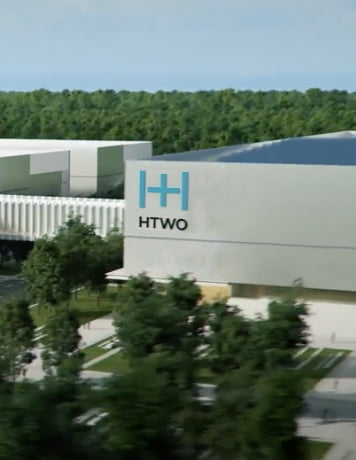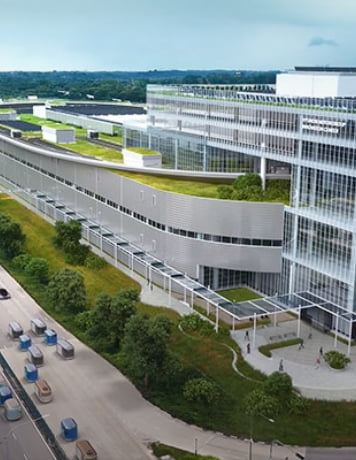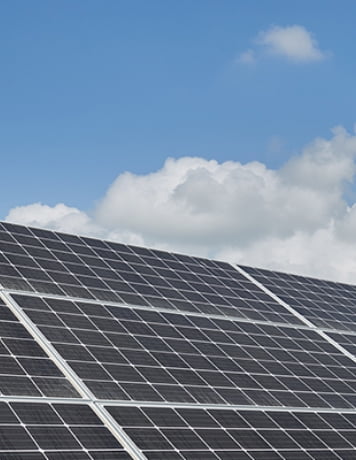
Hyundai Motor Company’s Carbon Neutrality Vision
In Progress with Positive Energy
‘Progress for Humanity’ represents Hyundai Motor’s commitment to realizing emissions-free mobility as a fundamental human right. Under this vision, we pledge to do the best thing for humanity and society to lead us all towards a better future. Starting with IONIQ, we have been proactively promoting a paradigm shift towards electrification and creating a hydrogen society. We’re doing so with the help of our extensive research from the past 20 years and using this to spearhead changes in the area of sustainability. We have the unwavering belief that we, as an automaker, have to be more active when responding to climate change than companies in other industries, and we feel a strong sense of responsibility. Our journey towards sustainability will continue for the sake of humanity and generations to come.
See the full press conference @ IAA 2021.
See 1 minute highlight of the press conference.
We are in a collision course with nature, draining the Earth of precious resources, and without our attention, it will be too late.
Change starts with an action, not opinions. Hence we stand upon such hope for the sustainable future.
Laying the foundations to improve lives, offering solutions that would build this planet more sustainable. Hyundai will be the change the world needs, taking the necessary steps to power progress.
This is not a reluctant obligation, but an invitation to the better world, driving positive change for a cleaner future.
In Progress with Positive Energy
Hyundai Motor Company is moving beyond mobility towards creating a sustainable future with circular economy. Based on hydrogen fuel-cell technology and an integrated solution which will cover the entire city, Hyundai will start with electrification and then go on to create a hydrogen society, smart city infrastructure for a sustainable future.
Our five main
areas of interest
to achieve
Carbon Neutrality
We will achieve 100% electrification of new vehicles in major markets in Europe by 2035 and worldwide by 2040.
Transportation is responsible for about 20% of the global carbon emissions, more than 70% of which come from road transport, including cars. To speed up the process of reducing carbon emissions and, by extension, achieving carbon neutrality, Hyundai Motor aims to achieve 100% electrification (through battery electric vehicles and fuel cell electric vehicles) in the European market by 2035 then to 100% electrification in major markets by 2040. To do so, we will establish electrified lineups for all types of commercial vehicles, including buses and heavy-duty trucks, by 2028 and expand to 100% electrification by 2035 in the Korean market and beyond. This will be boosted further after 2023, when we expand from one FCEV model to three. We’re planning to launch our new look NEXO in the second half of 2023, a STARIA-sized FCEV model at the end of 2023, and we’re reviewing our plans for launching large SUV-sized FCEV models after 2025. We will also utilize hydrogen power for other vehicles such as vessels, trains, and urban air mobility aircraft in the mid to long term.
We will open up a new era of electrification through investments in platform technology and charging infrastructure.
IONIQ 5, designed based on Hyundai Motor Group’s new EV platform E-GMP, has opened a whole new era for electric vehicles. The E-GMP enables us to create various future-ready mobility options, including autonomous cars and connected cars. This is made possible thanks to the E-GMP’s multi-charging system, which is compatible with various charging technologies, its large-capacity battery system, improved driving range, and flexible use of space.
Starting with the establishment of 120 stations in 2021, we will continue to build E-PIT charging stations in Korea. In 2019, Hyundai Motor Group signed joint investments worth 75m Euro with IONITY in Europe. IONITY was co-founded in 2017, by four automakers: BMW, Daimler, Volkswagen and Ford. By establishing a mutual system of cooperation through our equity investment, Hyundai Motor Group will accelerate the transition to clean mobility in Europe.
We will improve the efficiency of the national power grid and contribute to social net-zero carbon through our V2G and dead battery recycling business.
Hyundai Motor has been commercializing vehicle-to-grid or V2G, a next-generation charging technology that enables energy to be pushed back to the national/local power grid from the high-voltage battery of an electric car. If applicable for them, EV owners can recharge their cars during the night when there is a smooth supply of power and send electricity to the grid at peak time, contributing to the stable operation of the national grid. Since it allows flexible responses to be made when it comes to changes in power supply and demand, V2G can also help overcome the limitations of renewable energy.
As the number of dead batteries is expected to grow with the increasing sales of EVs, we plan to expand our battery recycling network from Korea to Europe, the US, and other regions worldwide. We are also promoting the SLBESS initiative so that an end-of-life battery can be reused as an energy storage device.
We will achieve net-zero carbon by 2040.
Although it is often believed that hydrogen power is just for cars, it can also serve as a source of energy for every type of mobility with a fuel cell system built in. Therefore, we will promote a hydrogen-led mobility evolution by applying hydrogen for all mobility options, beyond sedans towards commercial cars, public transportation, trams, vessels, Urban Air Mobility (UAM), and beyond. We will also advance the fuel cell system to enable widespread use in our daily lives and across industries to generate power, enable cooling and heating processes, and store energy. By doing so, we will promote hydrogen as a popular option, not just in the world of mobility but also in various other ways that support our daily lives and a range of industries.
Hyundai Motor signed an MOU with the US Department of Energy to enhance our cooperation in innovating hydrogen and fuel cell technology and to facilitate their global expansion. This allowed us to lay the foundation for greater EV use across the US and not just in California. We also signed an MOU with Guangzhou, China, and we are now constructing a hydrogen fuel cell system factory, ‘HTWO Guangzhou,’ which is scheduled to be completed in 2022. In 2020, Hyundai Motor introduced ‘HTWO’, a hydrogen fuel cell system brand using the world’s best technology, as we have global ambitions for the expansion of the hydrogen ecosystem.
We are maximizing the synergy effects of hydrogen power and achieving net-zero carbon emissions by producing green hydrogen based on renewable energy.
Ultimately, to achieve net-zero carbon emissions, it is inevitable that there will be a comprehensive shift from fossil fuels to renewable energy. The value of hydrogen is now being realized as a future energy source that can make up for the unstable supply of renewable energy. What matters to us most is shifting from grey hydrogen, most of which comes from fossil fuels to green hydrogen based on renewables. Hyundai Motor plans to secure renewable energy with RE100 – a global initiative for renewable energy and plans to produce green hydrogen. This green hydrogen will be used as a significant energy source for our EVs and, by extension, will serve as a replacement of LNG as a means of producing hydrogen to maximize the synergy effects of our hydrogen business and our net-zero goal.
For more information about the hydrogen society and hydrogen power, click on the links below.
Eco-friendly cars will be produced in green factories from 2045.
We actively support the direction and objectives laid out by the Paris Agreement and fully recognize the role and responsibility of businesses in reducing greenhouse gases worldwide. We pledge to cut carbon emissions by 2045 by realizing both electrification and the creation of a hydrogen society, shifting to renewable energy in our manufacturing processes, and increasing energy efficiency in our production by using high-efficiency motors and inverters.
With our group members – Kia, Hyundai Mobis, Hyundai Wia, and Hyundai Transys –, we are promoting the reduction of carbon to shift to the use of 100% renewable energy worldwide. To achieve this objective by 2045, 5 years earlier than the recommended timeline laid out by the global RE100 Initiative (Climate Group), we will complete the conversion to renewable energy at our plants in Europe, India, the US, and South Korea. As for our plants in India, around 85% of their electricity comes from renewable energy sources thanks to an external power company, and 3.2MW-scale solar panels have already been installed there. Roughly 19MW of electricity is produced by solar panels in our Korean plants in Asan and Ulsan, and the battery ESS is connected to the energy generated by solar power.
We are going beyond eco-friendly plants and building smart plants.
Here at Hyundai Motor, we believe that we can create a truly eco-friendly mobility ecosystem by advancing manufacturing technology and innovating the existing platforms. Together with our partners, we are building a Hyundai Motor Group Innovation Center in Singapore, otherwise known as HMGICS. This center will serve as a hub for creating an innovative mobility ecosystem and research on the mobility-related value chain, including vehicle delivery, test-driving, and other services.
A human-friendly working environment will be created by M-CHoRD, which is Hyundai Motor’s intelligent manufacturing platform that functions as a multi-vehicle production system with the ability to respond to market changes in a flexible way based on demand, human-robot cooperation system, musculoskeletal disease prevention technology, tutoring system for workers, etc. In addition, the HMGICS will evolve into a net-zero manufacturing hub through solar and hydrogen power generation. In order to promote the transition to clean mobility, we will be launching a new BaaS (Battery as a Service) business, alongside implementing our vision for future mobility vision with the introduction of our Smart City, UAM and Robotics technologies.
We pledge to achieve carbon neutrality throughout the entire value chain with the help of our partners.
The automotive industry not only includes manufacturing plants but also auto parts providers. Because Hyundai Motor’s overall competitiveness starts from its production of outstanding parts provided by our partners, we are also supporting them in many ways to help them improve their capabilities and competitiveness.
Aside from quality and technological support, we are going one step further to help them achieve carbon neutrality. We will monitor their carbon emissions, offer guidelines, promote activities for reducing carbon emissions, provide education, and create a cooperation program for our entire supply chain. This will be especially beneficial for providers of raw materials, which tend to emit a large amount of carbon emissions, so we will enhance our cooperation within automotive design technologies to increase our recycling of materials and improve our use of new materials.
On top of reducing our carbon emissions, we are also strengthening our efforts to absorb and remove carbon and recycle resources.
Carbon neutrality requires ending our use of fossil fuels altogether. But, from 2012, we have been developing Carbon Capture Utilization & Storage or CCUS technology, which captures and deals with the carbon emissions released while burning fossil fuels and we’ve implemented this in Korea. And we started to develop this technology to assist us during the transitional phase. In order to prepare for the commercialization of CCUS, including expanding to other industries beyond just the automotive industry, empirical research on the CCUS technology is being conducted at the Korean research institute, along with continuous market monitoring and ongoing technological development.
We are also maximizing our design efforts to increase the recycling of cars as well as batteries. We now use recycled plastic from old cars to manufacture automotive parts such as wheel guards, under covers, and battery trays. We also try to use eco-friendly materials as much as possible to produce the IONIQ 5. To reduce marine pollution, we reuse fishing nets from inside and outside of Korea and we’re conducting research on reusing carbon fibers from our HVs’ hydrogen tanks. We are also changing our entire manufacturing process to be more conducive to recycling.
For more information on our diverse eco-friendly CSV activities, click on the links below.




